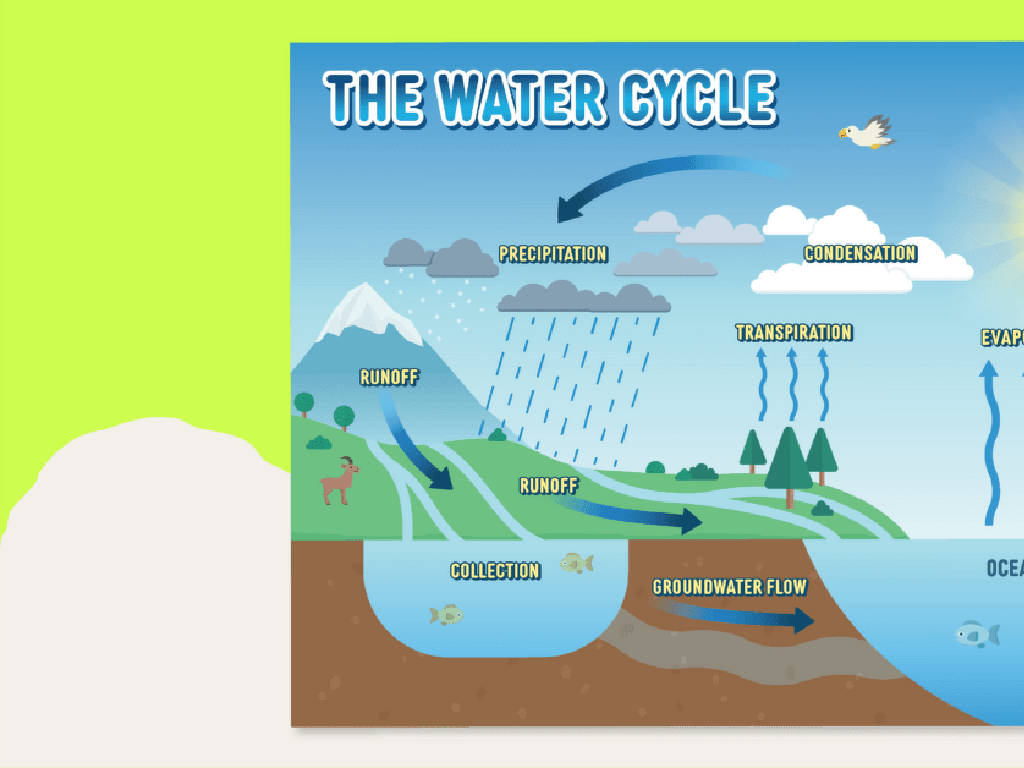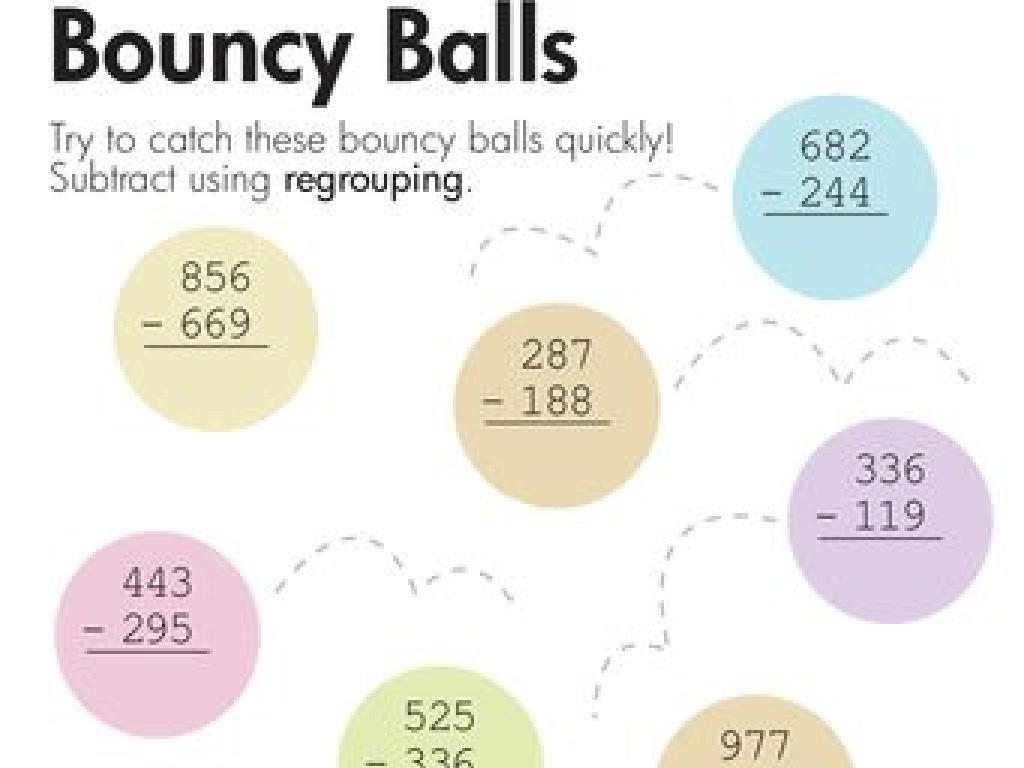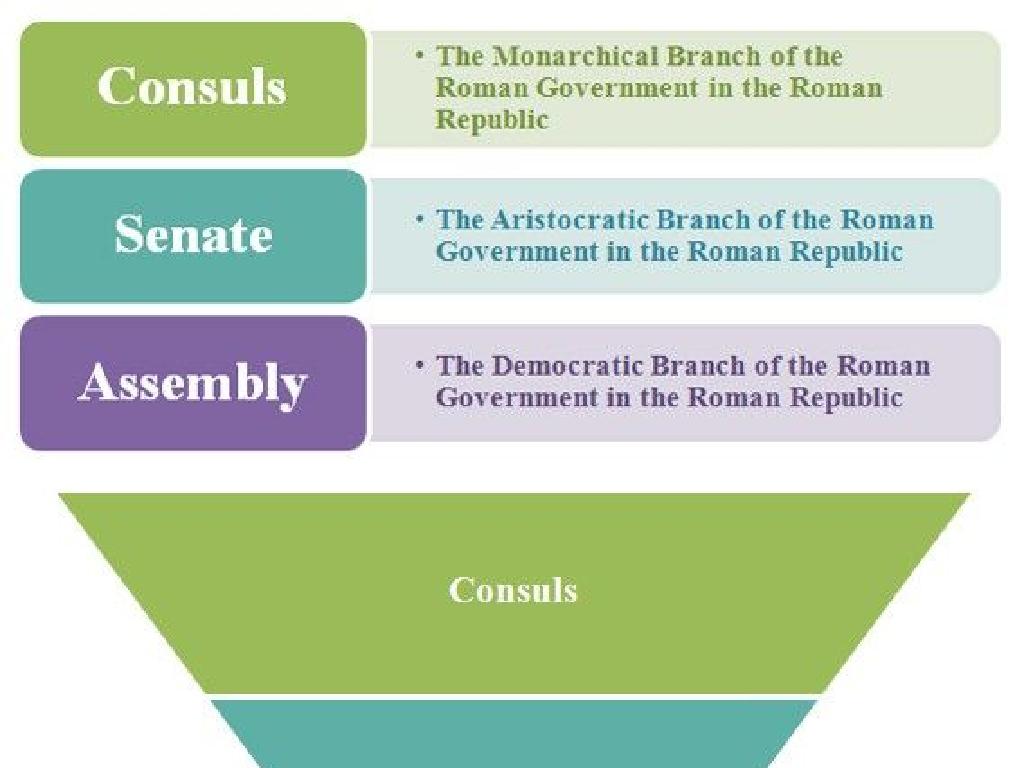Subtraction Sentences For Word Problems - Up To 20
Subject: Math
Grade: First grade
Topic: Subtraction Word Problems Up To 20
Please LOG IN to download the presentation. Access is available to registered users only.
View More Content
Welcome to Subtraction!
– Learning to take away numbers
– Subtraction shows what’s left
– If you have 5 apples and eat 2, subtraction tells you 3 are left.
– Practice with numbers up to 20
– We’ll subtract numbers from 1 to 20.
– Fun subtraction word problems
– Solve problems like: 10 balloons – 4 popped, how many left?
|
This slide introduces first graders to the concept of subtraction as a means of determining how many items remain after some have been taken away. Emphasize that subtraction is simply ‘taking away’ and it helps us figure out the quantity that remains. Use relatable examples, such as apples or balloons, to illustrate the concept. During the lesson, provide hands-on practice with a variety of subtraction problems that involve numbers up to 20. Encourage students to visualize the problems with real objects or drawings to enhance understanding. The goal is to make subtraction fun and relatable, building a strong foundation for their math skills.
Understanding Subtraction
– Subtraction means taking away
– Imagine you have 5 apples and you eat 2. Now you have 3.
– Finding the difference between numbers
– If you start with 10 toys and give 4 to a friend, how many do you have left?
– It’s like giving away cookies
– For example, 5 cookies minus 2 cookies equals 3 cookies.
|
This slide introduces the concept of subtraction to first graders by relating it to a tangible experience like sharing cookies. Start by explaining that subtraction is simply the process of taking some away from a larger group. Use real-life examples that are relatable to the students, such as having a certain number of cookies and giving some away, to illustrate the concept of finding the difference. Encourage the students to visualize the action of subtraction to better understand the concept. Reinforce the idea by asking the students to think of times they have shared or given things away and how that relates to subtraction.
Crafting Subtraction Sentences
– Subtraction sentence elements
– Numbers, a minus sign (-), and an equals sign (=)
– Example: 5 – 2 = 3
– 5 apples – 2 apples = 3 apples left
– Writing our subtraction sentences
– Use objects like apples to visualize taking away
|
This slide introduces the concept of subtraction sentences to first graders. Begin by explaining the components of a subtraction sentence, emphasizing the minus sign and equals sign. Use concrete examples, such as apples, to illustrate the concept of ‘taking away.’ After explaining with the example provided, encourage students to create their own subtraction sentences using items they are familiar with. This could be toys, crayons, or even snacks. The goal is to help them visualize the subtraction process and understand the relationship between the numbers in the sentence. During the next class, students can share their sentences and explain the scenarios they’ve come up with, reinforcing their understanding through peer learning.
Reading Subtraction Word Problems
– Word problems are number stories
– Careful reading helps find subtraction
– Understand what numbers to subtract and why
– Let’s read a problem together
– Example: ‘Sam had 10 apples, ate 2. How many left?’
– Practice makes perfect
|
This slide introduces students to the concept of subtraction word problems. Emphasize that word problems are like stories that involve numbers, and the goal is to find out what numbers to subtract to solve the problem. Encourage students to read the problem slowly and carefully to understand what is being asked. Walk through an example problem as a class, demonstrating how to identify the important information and the numbers that need to be subtracted. Provide additional practice problems for students to try on their own, reinforcing the concept that practice will help them become more comfortable with subtraction word problems.
Crafting Subtraction Sentences
– Find numbers in the story
– Determine what’s taken away
– Write the subtraction sentence
– For example, if 3 apples are taken from 10, write 10 – 3.
– Check sentence with the story
– Ensure the sentence fits the story’s context.
|
This slide is aimed at teaching first graders how to create subtraction sentences from word problems. Start by guiding them to identify the numbers involved in the problem. Next, help them understand what items or quantities are being removed. Then, show them how to represent this action using a subtraction sentence. For instance, if a story talks about a child having 10 candies and giving away 3 to a friend, the subtraction sentence would be 10 – 3. After writing the sentence, encourage students to check if their sentence accurately reflects the story. Use simple, relatable examples to ensure comprehension. Practice with several examples and provide immediate feedback.
Let’s Practice Subtraction Together!
– I’ll read a word problem aloud
– Listen for numbers and subtraction
– Identify the numbers and what is being taken away
– Help write the subtraction sentence
– Use the board to form the subtraction equation
– We’ll solve the problem as a team
|
This interactive slide is for a classroom activity where the teacher will read a word problem to the class, and the students will actively listen to identify the numbers involved and understand the subtraction taking place. The teacher will guide the students to help write the subtraction sentence on the board, reinforcing the concept of subtraction as ‘taking away.’ After forming the sentence, the class will solve the problem together, ensuring that students grasp the process of translating a word problem into a mathematical equation. The teacher should prepare a simple word problem in advance, such as ‘If there are 15 apples and we eat 5, how many are left?’ and walk through the problem-solving steps with the class.
Your Turn to Solve: Subtraction Stories
– Receive your subtraction worksheet
– Read and visualize the word problems
– Picture the story in your mind to help solve it
– Write subtraction sentences
– Use numbers to show taking away, like 15 – 7 = ?
– Share your answers with the class
|
This slide introduces an interactive class activity where students will apply their understanding of subtraction to solve word problems. Distribute worksheets with age-appropriate subtraction word problems. Encourage students to read each problem carefully and to visualize the scenario to aid their comprehension. Guide them to translate the story into a subtraction sentence, reinforcing the concept of ‘taking away.’ After completing the worksheet, students should be prepared to discuss their answers and methods with the class. This exercise will help solidify their understanding of subtraction in real-world contexts and enhance their problem-solving skills.
Class Activity: Subtraction Scavenger Hunt
– Scavenger hunt for numbers
– Create subtraction word problems
– Find items, think ‘If I have 5 crayons and give away 2, how many are left?’
– Pair up and share problems
– Solve problems with a friend
– Work together to find the answer
|
This interactive activity is designed to help first graders apply their subtraction skills in a fun and engaging way. Set up the classroom with various objects that have numbers on them. Students will search for these objects and use them to create their own subtraction word problems. Encourage creativity and ensure the numbers involved are within the 0-20 range. Once they’ve created their problems, they will pair up with classmates to exchange and solve them. This peer interaction reinforces their understanding and allows them to practice verbalizing and solving subtraction problems. Provide guidance and support as needed, and consider preparing a few examples to demonstrate the activity. Possible variations include timed hunts, team competitions, or themed problems.
Subtraction Success!
– Congratulations on learning subtraction!
– Subtraction finds the remaining number
– If you have 5 apples and eat 2, subtraction tells us 3 are left.
– Practice makes perfect
– The more you practice, the better you’ll get at quick subtraction.
– Aim to be a subtraction star!
|
This slide is meant to wrap up the lesson on subtraction sentences for word problems up to 20. It’s important to reinforce the concept that subtraction is a tool we use to find out how many items or things are left after some are taken away or used. Encourage the students to keep practicing with different word problems to become more comfortable with subtraction. Remind them that with consistent practice, they’ll become subtraction stars in no time. You can suggest that parents help their children practice at home with simple everyday activities, like counting toys or snacks.






